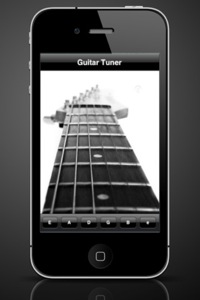Buying a
Classical Guitar Tuner
A classical guitar tuner helps you tune each string to the correct pitch.
Most people don't put much thought into buying a guitar tuner, but it's actually more important than you might think. You should carefully consider the pros and cons of each tuner before deciding which one to buy. Read about each tuner below.
Handheld Electronic Tuner
Handheld electronic tuners are probably the easiest to use of all the tuners. When you play a note, a needle moves right and left to show you how "in-tune" you are - no guesswork involved.
Click on the link below to buy an electronic tuner from Guitar Center's website.

Pros
- No Guessing - this tuner does not require a trained ear to "hear" whether you are in-tune or not. The needle tells you exactly how much higher or lower you need to tune.
Cons
- Requires Batteries - Batteries are always a hassle. You don't want your tuner to run out of power right before a concert!
- Noise Interference - This tuner uses a microphone to detect the pitch. So if you try to tune your guitar in a noisy environment, the microphone will not be able to hear the pitch correctly.
Clip-On Tuner
The clip-on tuner is similar to the handheld electronic tuner, except it clips right onto the head of the guitar. When you play a note, it detects the vibration through the wood, and tells you whether the note is in-tune or not.
Click on the link below to buy a clip-on tuner from Guitar Center's website.

Pros
- No Guessing - this tuner uses arrows to show you whether you are in tune or not, so you do not need to have a trained ear.
- Very Portable - You never have to take it off your guitar! It clips right onto the head. Pull it out when you want to tune, and fold it back when you are done. It even fits inside your guitar case, so you will never forget it!
- No Noise Interference - since the tuner "feels" the vibrations of the guitar through the wood, you can tune in a noisy environment without any interference.
Cons
- Uses Batteries - like the handheld tuner, the clip-on tuner uses batteries. It will sometimes "die" at inconvenient times.
Tuning Fork
This a very traditional and simple tuner. Just hit it against something, and it rings at a correct pitch!
Click on the link below to buy a tuning fork from Guitar Center's website.

Pros
- SImple - You don't need to worry about using any electronics. It's very simple and intuitive.
- Durable - It's almost impossible to break a tuning fork. Once you buy one, you can use it for the rest of your life!
Cons
- Only Plays One Note - the tuning fork can only ring at one note frequency. Once you tune to that one note, you need to tune all the other strings "relatively."
- Easy to Lose - Tuning forks are very easy to misplace. I have lost mine several times.
Smartphone Tuner
Download a tuning app. on your smartphone so that you can access a tuner wherever you go! There are hundreds of apps you can choose from.

Pros
- Easy to Access - since you carry your smartphones with you everywhere, you will always have a tuner
- Many Options - there are many different tuning apps, so you can try a few to see which one you like the most.
Cons
- You Need a Smartphone - of course, if you don't have a smartphone already, you won't be able to use this type of tuner.
- Sound Quality Sometimes Bad - if you have a phone with bad speakers or microphone, the tuner may not work so well.
Free Online Tuners
Search "free guitar tuner" on google and you will find thousands of options! Unfortunately, they usually come with lots of advertisements and pop-ups.
Pros
- Free - most of the online tuners are completely free!
- Many Options - you can search until you find a tuner that you like.
Cons
- Need Your Computer - You will always need to have your computer with you to tune. If you need to tune outside of home, this could be a hassle.
- Advertisements - since the tuners are free, you need to deal with advertisements on a daily basis.
Copyright 2014 © ClassicalGuitar101.org | All Rights Reserved
Popular Articles:
Making a Living as a classical guitarist
List of Classical Guitar Competitions
About Me
My name is Daniel Nelson, and I am a classical guitar teacher and performer from Los Angeles, California. Click here to learn more.
Leave a Comment!